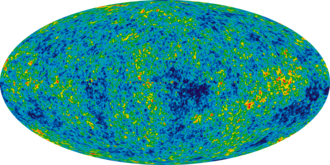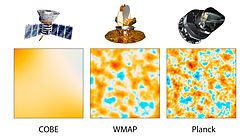1965 ⟶ Cosmic Microwave Background (CMB) Discovered
Arno Penzias and Robert Wilson: Cosmic Microwave Background ...Year
1965
1992
2003
2009
🔭 Cosmic Microwave Background (CMB) Discovered
Arno Penzias and Robert Wilson: Cosmic Microwave Background (CMB) discovered⟶

CosmologyBig BangCosmic Microwave BackgroundArno PenziasRobert WilsonEarly UniverseRadio Astronomy1960sDiscovery
 United States
United States🌌 Discovery of the Cosmic Microwave Background
Arno Penzias and Robert Wilson announce the discovery of a weak radio signal coming from all parts of the sky. Scientists figure out that this must be emitted by an object at a temperature of −270 °C. Soon it is recognized as the remnant of the very hot radiation from the Big Bang that created the universe 13 billion years ago, see Cosmic microwave background.⟶

CosmologyBig Bang TheoryArno PenziasRobert WilsonCosmic Background RadiationEarly Universe1960sRadio AstronomyUniverse Expansion
 United States
United States🌌 Cosmic Background Explorer Satellite Maps Big Bang Radiation
The Cosmic Background Explorer satellite produces a detailed map of the background radiation remaining from the Big Bang. The map shows "ripples", caused by slight variations in the density of the early universe – the seeds of galaxies and galaxy clusters.⟶

CosmologyBig BangCosmic Microwave BackgroundAstronomyEarly UniverseSatelliteGalaxy FormationCosmic Background Explorer
 USA
USA🌌 WMAP Observations of Cosmic Microwave Background
WMAP observations of cosmic microwave background⟶

CosmologyCosmic Microwave BackgroundWMAPBig Bang TheoryAstrophysics21st Century ScienceEarly Universe
 United States
United States📡 Planck Space Telescope Begins Observing Cosmic Microwave Background
Planck begins observations of cosmic microwave background⟶

CosmologyCosmic Microwave BackgroundBig BangPlanckSpace TelescopesEarly Universe21st Century ScienceInflationObservational Astronomy